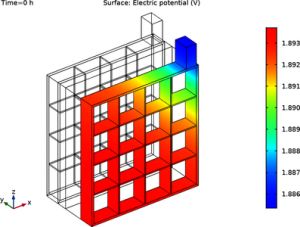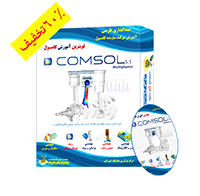مدلسازی توزیع جریان در یک شبکه باتری سرب-اسید سهبعدی
این مثال مدل سهبعدی نشان میدهد استفاده از رابط باتری سرب-اسید برای مدلسازی توزیع فعلی در سلول کامل با استفاده از شیمی باتری سرب-اسید صورت میگیرد. شیمی باتری سرب-اسید از PbO2 به عنوان الکترودهای مثبت متخلخل و از Pb به عنوان الکترودهای متخلخل منفی و از H2SO4 به عنوان الکترولیت استفاده میکند. در یک الکترود سنتی سرب-اسید، الکترود متخلخل توسط یک شبکه پلاستیکی پوشش داده شده با مس با مواد الکترود از طریق شبکه پشتیبانی میشود. شبکه مس با پوشش مس، هدایت الکتریکی را نیز فراهم میکند. تجزیه و تحلیل طراحی شبکه میتواند به افزایش عملکرد و طول عمر منجر شود. در اینجا، تخلیۀ یک سلول کامل را در جریان تخلیه ۲C مطالعه میکنیم. توزیع SOC و جریان در ماتریس متخلخل مورد بررسی قرار گرفته است. توزیع بالقوه در ستون فقرات پلاستیکی پوشش داده شده با مس به وضوح از طریق استفاده از رابط پوستۀ الکترود مورد بررسی قرار گرفته است.
متن فوق به زبان انگلیسی:
Modeling Current Distribution in a 3D Lead-Acid Battery Grid Battery
This 3D model example demonstrates the use of the Lead-Acid Battery interface for modeling current distribution in full cell employing a lead-acid battery chemistry. The lead acid battery chemistry uses PbO2 as the positive porous electrode and Pb as the negative porous electrode and H2SO4 as the electrolyte. In a traditional lead-acid electrode, the porous electrode is supported by a copper coated plastic grid with electrode material supported via grid. The copper coated grid also provides electronic conduction throughout the electrode. Analyzing the design of the grid can lead to increased performance and lifetime. Here we study the discharge of a full cell at 2C discharge current. The SOC and current distribution is studied in the porous matrix. The potential distribution in the copper coated plastic backbone is studied explicitly via using the Electrode, Shell interface.
طبق قانون ۶۲ ۶۳ ۷۴تجارت الکترونیک تمامی حقوق ” ساختنی” این وبسایت محفوظ است© استفاده از مطالب تنها با ذکر منبع مجاز خواهد بود





